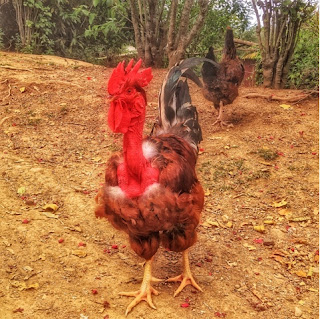Healthy Chickens for Healthy Corals
Here is the “Naked Neck Chicken”. How is it connected to a healthy ocean? There is a very interesting effort happening in the South Pacific: Healthy Chickens for Healthy Corals - led by Dr. Austin Bowden-Kerby aka - father of Coral Gardening. Corals and Chickens? Hope your eyebrows are now raised and you have many question marks in your head - interesting? Please read on.
Until the end of the 19th century Fijian communities relied heavily on chickens for their protein. At that point Fijians were introduced to the mongoose to get the rat population under control. However, according to many local and scholarly accounts, they also wiped out populations of other species - including snakes, birds and unfortunately chickens. Culturally in Fiji, farms or other “territories” are not fenced in - everything literally roams free - cows, goats, sheep and chickens. Now in most coastal areas there are no chickens. They are mostly found in markets by farmers living up around the mountains - at $18 for a dozen of eggs - it’s an expensive source of protein for those earning $10 a day. Imagine paying your 2 day worth of salary to buy eggs?
 |
| An increasingly rarer Giant Clam - Coral Coast, Fiji |
Today - local coastal communities continue to rely on coastal fishing during low tide as a major source of protein in their diets. Most of the time they collect fish - parrotfish, the now very rare honeycomb grouper; and mostly invertebrates - octopus, top shells, sea cucumbers, sea urchins, baby giant clams; that are crucial to keeping the reefs healthy and clean. Without this life the reef can only grow and bloom so much before becoming vulnerable to other forms of life - i.e. crown of thorns. Especially as the corals are struggling to remain healthy every living being is playing a crucial role in helping them grow - either eating away the algae, fending off from other harmful fish or disease. The balance is so fragile - the removal of each parrotfish makes a difference to the depth of the waters surrounding the beaches. Farmer fish prevent parrotfish from living in corals they spread disease from one coral to the other - yet they are not hunted, they are too small. Grouper eat farmer fish. Groupers are hunted. Removal of each grouper from these fragile waters mean less parrotfish. Another problem with this approach is due to the scarcity of the fish. The majority of the population is protein deficient. There aren’t enough fish in the waters to provide a healthy diet.
It’s up to visionaries in the community to come up with alternatives for local communities. The mongoose eat baby chickens. “Healthy Chickens for Healthy Reefs” project is an initiative to provide a better protein alternative. Dr. Austin Bowden-Kerby is re-introducing chickens as a healthy and easy source of protein (and income) to coastal villages - ensuring a cage-free existence, organic diet and healthy productivity. An innovative variety - the naked neck chicken can tolerate hotter temperatures and continue to lay eggs through the very hot summer months in Fiji. In the new Happy Chicken approach the chickens continue to roam free for the majority of their lives - they are protected from the mongoose by keeping the baby chickens in open field pens (fenced in) until they are large enough to avoid the hunter. Dr. Bowden-Kerby spends the large portion of his days taking care of his chickens developing better ways to keep the chickens happier and the people and corals healthier. Once they are full size - they are roaming free as always, the Fijian way. Incentive for locals to change their ways and rely more on land rather than the sea. Communities coming together to build new practices, sell their eggs, earn an income, ensure healthier diets and days for their children providing an organic, healthy, reliable and sustainable protein source.
Locals understand that the health of corals also mean the health of life for future generations. They notice the change in the abundance of life in the waters. They notice the reduced quality and size of their daily catch. They also notice the reduced area of healthy coral habitat they can hunt - “there used to be many clams and fish right here” they say - as they stand in an area of shore with nearly no sign of life. The Healthy Chicken for Healthy Reefs project is met by enthusiasm by all villagers and even many resort owners to support locals to create chicken farms and no-take areas in the water. With a little bit of healthy social collaboration it’s back to nature where all life forms are connected and everybody wins.





Comments
Post a Comment